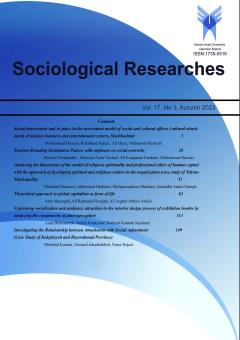Analysis of dimensions of religious spirituality culture model and professional ethics of human capital with the approach of developing spiritual organizational culture in the organization (case study of Tehran Municipality Organization)
Subject Areas :mhrdad mansori 1 , Seyed mhmod hashmi 2 , mohamad reza mardani 3 , zein alabedin amini sabegh 4
1 - PhD student in Public Administration, Faculty of Humanities, Islamic Azad University, Saveh branch
2 - Faculty member, Faculty of Management, Islamic Azad University, North Tehran branch
3 - Associate Professor, Department of Human Resource Management, Faculty of Management and Strategic Planning, Imam Hossein University
4 - Islamic Azad University
Keywords: Professional ethics, spiritual culture, human capital, organizational culture,
Abstract :
The current research has been carried out with the aim of analyzing the dimensions of the model of religious spirituality culture and professional ethics of human capital with the approach of developing a spiritual organizational culture in the organization (the case study of Tehran Municipality Organization). The qualitative research method is based on the data theory of the foundation. 160 articles were collected in the content analysis section of which 80 domestic (from 1398 to 1401) and foreign (2018 to 2022) articles were categorized, the data analysis method in the section Qualitative using open coding, axial coding and selective coding, basic indicators were extracted. The interview questions were designed under the supervision of the scientific committee and designed as a semi-structured interview. Targeted sampling method by snowball method, 30 of them were selected as a sample until theoretical saturation. The results of the current research led to the identification of 6 codes and 18 codes out of 275 were open codes. The main index includes the identity of individual religious spirituality, including sub-components, establishment of organizational spirituality, individual professional ethics, establishment of organizational professional ethics, organization's human resources management and leadership style. It was an organization. In the second round, a Likert questionnaire was sent to 30 experts to determine the intensity of the effect of each component. The components and sub-components in the proposed model were specified


